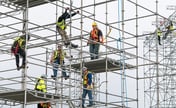 The Occupational Safety and Health Administration (OSHA) has issued massive revisions to its regulations requiring most employers (“General Industry”, in OSHA parlance), to protect employees from slip and fall hazards in most workplace contexts, including:
The Occupational Safety and Health Administration (OSHA) has issued massive revisions to its regulations requiring most employers (“General Industry”, in OSHA parlance), to protect employees from slip and fall hazards in most workplace contexts, including:
-
Walking-working surfaces – to reduce slips and falls even when floors are level or nearly level.
-
Stairs and ladders – used by employees to travel between levels within a workplace, or to work at elevation from the floor.
-
Barriers at the perimeters of elevated work areas -- passive protection such as guardrails and toeboards against employee falls or being hit by falling objects.
-
Personal fall protection systems – used by employees working at significant elevations, including window washers and billboard crews (note OSHA issued a new standard (29 CFR 1910.140) covering these systems effective January 17, 2017).
My last note (here) discussed the revised requirements for walking-working services, and for pathways (such as stairs and ladders) between levels. This note discusses fall protection systems and training requirements.
Requirements for Scaffolds and Rope Descent Systems
OSHA requires protections for workers who work at hazardous elevations above normal floors or platforms, by establishing standards for scaffolds, and for rope descent systems.
-
Scaffolds. OSHA defines a scaffold as “any temporary elevated or suspended platform and its supporting structure, including anchorage points, used to support employees, equipment, materials, and other items. For purposes of this subpart, a scaffold does not include a crane-suspended or derrick-suspended personnel platform or a rope descent system.” Effective January 17, 2017, OSHA has replaced its (outdated) detailed standards for employers subject to General Industry standards with a cross-references requiring them to provide scaffolds that meet the requirements in OSHA’s Construction Industry standards (29 CFR 1926).
-
Rope Descent Systems. OSHA is adding detailed requirements for these systems, which it defines as “a suspension system that allows an employee to descend in a controlled manner and, as needed, stop at any point during the descent. A rope descent system usually consists of a roof anchorage, support rope, a descent device, carabiner(s) or shackle(s), and a chair (seatboard).” The primary difference from a “scaffold” is that the employee works from a chair or seatboard rather than standing on a platform. This new standard includes detailed construction and performance standards for the anchorages and equipment, and generally limits use of these systems to heights no higher than 300 feet.
Employer Duty and Detailed Requirements for Fall Protection
OSHA requires employers to protect their employees from falls. Effective January 17, 2017, OSHA defines a fall hazard as “any condition on a walking-working surface that exposes an employee to a risk of harm from a fall on the same level or to a lower level.” However, these requirements do not apply to art installations and entertainment venues, or when superseded by other, more specific standards (such as powered platforms, and telecommunications work). OSHA presents these requirements in three related standards:
-
Duty to protect employees from these hazards
-
Guardrail systems
-
Safety net systems; or
-
Personal fall protection systems, such as personal fall arrest, travel restraint, or positioning systems.
-
Hoist areas.
-
Holes.
-
Dockboards.
-
Locations above dangerous equipment.
-
Openings at least 30 inches high and at least 18 inches wide, through which an employee can fall to a lower level.
-
Repair pits, service pits, and assembly pits shallower than 10 feet.
-
Fixed ladders (that extend more than 24 feet above a lower level).
-
Outdoor advertising (billboards).
-
Stairways.
-
Scaffolds and rope descent systems.
-
Work on low-slope roofs.
-
Compliance with criteria and practices for these systems
OSHA provides detailed requirements for employers to meet.
-
Provisions for “designated areas”
OSHA also provides separate criteria for a “designated area,” which it defines as “a distinct portion of a walking-working surface delineated by a warning line in which employees may perform work without additional fall protection.” OSHA provides detailed specifications for how to designate such an area, how to mark the area so employees distinguish safe from hazardous places in the workplace, and how to train employees.
Employer Duty and Detailed Requirements for Protection Against Falling Objects
Effective January 17, 2017, OSHA requires employers to provide the following protection for employees who are exposed to the risk of falling objects:
-
Head protection that meets applicable personal protective equipment (PPE) standards
-
One or more of the following protective measures, in compliance with applicable requirements:
- Toeboards, screens, or guardrail systems to prevent objects from falling to a lower level.
- Canopy structures and measures to keep potential falling objects far enough from an edge, hole, or opening to prevent them from falling to a lower level.
- Barricades around the area into which objects could fall, and prohibitions to keep employees from entering the barricaded area, and measures to keep objects far enough from an edge or opening to prevent them from falling to a lower level.
Training
Effective January 17, 2017, OSHA requires employers to provide initial training in fall and equipment hazards before the employee is exposed to these hazards, and may require retraining later. Compliance is required on or before May 17, 2017.
-
Training must be by a qualified person.
-
Initial training to each employee must cover at least the following topics:
- Fall hazards in the work area and how to recognize them
- Procedures for installing, inspecting, operating, maintaining, and disassembling the workplace’s personal fall protection systems
- Correct use of personal fall protection systems and equipment used, including at least proper hook-up, anchoring, and tie-off techniques, and methods of equipment inspection and storage specified by the manufacturer.
-
Retraining must be provided when the employer has reason to believe the employee does not have the understanding and skill required by these training requirements. OSHA identifies that situations requiring retraining include the following:
- Changes in the workplace render previous training obsolete or inadequate
- Changes in the types of fall protection systems or equipment to be used render previous training obsolete or inadequate; or
- Inadequacies in an affected employee’s knowledge or use of fall protection systems or equipment indicate that the employee no longer has the requisite understanding or skill necessary to use equipment or perform the job safely.
Implementation Checklist
Does the organization operate any workplaces where workers may be exposed to:
-
Fall hazards.
-
Hazards from falling objects.
If so, does the organization assess those hazards:
-
Walking-working surfaces
-
Movement between levels (e.g., stairs or ladders)
-
Elevated working areas from which workers could fall or drop objects onto co-workers below.
Does the organization provide protective measures?
Is the organization reconsidering hazards and protective measures in order to provide compliance with newly-revised OSHA requirements?
Where Do I Go For More Information?
Information available via the Internet includes:
-
OSHA webpage for this rulemaking
-
OSHA revisions (as published in the Federal Register; 513 pages including discussion)
Specialty Technical Publishers (STP) provides a variety of single-law and multi-law services, intended to facilitate clients’ understanding of and compliance with requirements. These include:
-
OSHA Auditing - Federal Compliance Guide: Facilities: The Complete Safety & Health Audit Checklist
-
OSHA Auditing - California Occupational Health and Safety Audit Guide
-
Workplace Violence Prevention: A Practical Guide to Security on the Job
About the Author
 Jon Elliott is President of Touchstone Environmental and has been a major contributor to STP’s product range for over 25 years. He was involved in developing 13 existing products, including Environmental Compliance: A Simplified National Guide and The Complete Guide to Environmental Law.
Jon Elliott is President of Touchstone Environmental and has been a major contributor to STP’s product range for over 25 years. He was involved in developing 13 existing products, including Environmental Compliance: A Simplified National Guide and The Complete Guide to Environmental Law.
Mr. Elliott has a diverse educational background. In addition to his Juris Doctor (University of California, Boalt Hall School of Law, 1981), he holds a Master of Public Policy (Goldman School of Public Policy [GSPP], UC Berkeley, 1980), and a Bachelor of Science in Mechanical Engineering (Princeton University, 1977).
Mr. Elliott is active in professional and community organizations. In addition, he is a past chairman of the Board of Directors of the GSPP Alumni Association, and past member of the Executive Committee of the State Bar of California's Environmental Law Section (including past chair of its Legislative Committee).
You may contact Mr. Elliott directly at: tei@ix.netcom.com.

